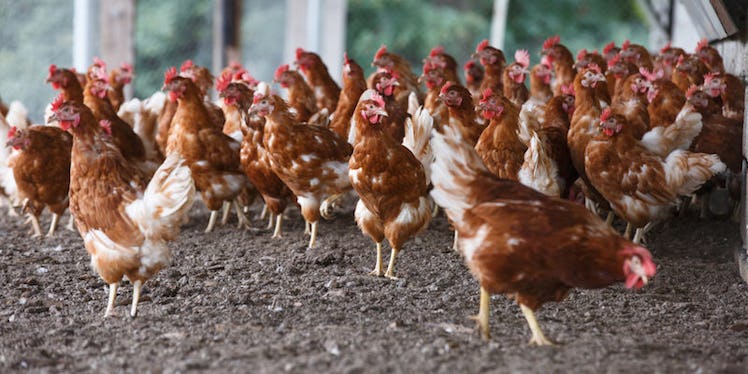
How Agricultural And Animal Farming Is Slowly Killing Our Environment
Farming and raising animals for food has been a part of our society for hundreds of years.
However, this had been done on a small, sustainable scale until the advent of industrial agriculture.
Farmers rotated crops and moved animals from summer to winter pastures with the environment in mind.
Why? Because they knew that without that environment, their farming wouldn’t produce enough food to sustain the animals.
Human populations have increased exponentially since the days of simple farming, and industrial agriculture has become one of the only ways to grow and provide enough food for the ever-growing number of humans who inhabit this planet.
But how does this affect our world?
"Cowspiracy" Theories
Environmental activist groups have long blamed agricultural farming for all of the world’s ills, from global warming to the drought in California.
The 2014 documentary, “Cowspiracy,” claims that animal farming accounts for the biggest waste of agricultural resources, and should be altered or eliminated in favor of sustainability.
These opinions are not exclusive to "Cowspiracy" theorists.
A quick Google search about the impact of agriculture or animal farming brings up thousands of similar blogs and websites.
If so many people believe the focus on agricultural farming is negative, then why is it a multi-billion dollar industry?
A Dirty Business
Pollution, both natural and man-made, is of primary concern to farming.
Animal farming creates enormous amounts of manure, which can carry other substances like antibiotics or the hormones that are fed to the animals.
These substances can damage any ecosystem they are exposed to, and they frequently make their way into the water systems.
An example of this problem on the east coast is Chesapeake Bay, which is currently dealing with pollution due to agricultural runoff.
The problem in the Bay is there is an excessive amount of nitrogen and phosphorus in the water, both of which promote the growth of algal blooms.
This is creating "dead zones" in the rivers, due to the lack of sunlight and oxygen in the water.
They are consequently killing animals.
Some of this algae is even toxic. It can sicken humans and adversely affect the nervous system and liver of the animals (if it doesn't kill them first).
The biggest movement in the agriculture industry is the campaign toward reducing the overall carbon footprint of the industry while moving toward sustainability.
This falls into two categories: agriculture and animal farming.
Agriculture
Farmers have come to rely heavily on industrial tools to keep up with the sheer amount of food they need to grow each year.
Therefore, the easiest place to make changes and help reduce carbon footprint is in those tools themselves.
Manufacturers of threshers, combines and other farming tools are tweaking these devices to be more fuel-efficient, reduce emissions and last longer.
In this way, fewer large mechanical devices are left to rust in fields and junkyards.
The push toward a more organic farming style is also a great way to help improve overall sustainability.
The process uses fewer chemicals that could potentially harm both the environment and the people consuming the food.
Animal Farming
Animal farming is tricky because of the sheer amount of space these animals take up while they are growing, as well as the food they consume and the waste they produce.
The best solution would be to switch from factory-raised animals to pasture-raised ones.
But with the current state of meat consumption in the United States alone, this would not be feasible.
An unrealistically large amount of space would be needed to pasture-raise all the animals that would be consumed in a single year.
Pasture-raised animals tend to be healthier.
If we allow cows, for example, to graze instead of forcing them to eat corn and other grains they cannot easily digest, they will live healthier, more easily managed lives.
They will not require as many antibiotics as factory-raised animals might.
We should stop feeding cows human food because they can exist quite happily on plant matter and grasses that humans can't eat.
Steps To Take As A Consumer
As a person who enjoys a good burger or medium-rare steak now and then, how can you help create this green, sustainable world?
The biggest steps you can take are to shop smart and reduce your overall meat consumption.
The average American eats more than 275 pounds of red meat every year.
Reducing your meat consumption can help reduce the overall carbon footprint of the animal farming industry.
Shopping smart is the other step you should consider.
If possible, try to buy your produce from small, independent farms or farmers instead of the grocery store.
Not only are you bolstering the economy by supporting small businesses, you’re likely getting produce that is organic, not treated with pesticides and better for you in the long run.
The Verdict
Is agricultural farming affecting our environment? The short answer is "yes."
But the farming industry has changed so much in the last 100 years, you can’t just leave it at that.
Are we potentially damaging the environment with our agriculture and animal farming practices?
Yes.
But. we are also taking enormous steps to lessen that damage and improve our overall impact on the world.
We’ve already done the damage, and the sooner we own up to that fact, the sooner we can take the steps we need to repair the it and move forward in a responsible manner.
We will always need farms and farmers to run them.
We just have to be more responsible in terms of how we grow our food and raise the animals we eat.
Improving your carbon footprint and buying from small, organic farms may seem like baby steps in the face of all of the damage we’ve already done.
But, you can’t get anywhere if you don’t get started.
At least it's a step in the right direction.